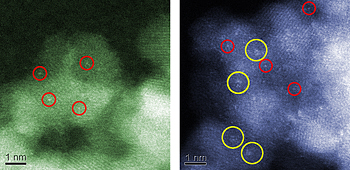Home > Press > NIST and Partners Identify Tiny Gold Clusters as Top-Notch Catalysts
 |
| Electron micrographs showing inactive (left) and active (right) catalysts consisting of gold particles absorbed on iron oxide. The red circles indicate the presence of individual gold atoms. The yellow circles show the location of subnanometer gold clusters that can effectively catalyze the conversion of carbon monoxide to carbon dioxide. One nanometer is about half the size of a DNA molecule. (Color added for clarity)
Credit: Lehigh University Center for Advanced Materials and Nanotechnology |
Abstract:
For most of us, gold is only valuable if we possess it in large-sized pieces. However, the "bigger is better" rule isn't the case for those interested in exploiting gold's exceptional ability to catalyze a wide variety of chemical reactions, including the oxidation of poisonous carbon monoxide (CO) into harmless carbon dioxide at room temperatures. That process, if industrialized, could potentially improve the effectiveness of catalytic converters that clean automobile exhaust and breathing devices that protect miners and firefighters. For this purpose, nanoclusters—gold atoms bound together in crystals smaller than a strand of DNA—are the size most treasured.
NIST and Partners Identify Tiny Gold Clusters as Top-Notch Catalysts
GAITHERSBURG, MD | Posted on September 8th, 2008Using a pair of scanning transmission electron microscopy (STEM) instruments for which spherical aberration (a system fault yielding blurry images) is corrected, researchers at the National Institute of Standards and Technology (NIST), Lehigh University (Bethlehem, Pa.) and Cardiff University (Cardiff, Wales, United Kingdom) for the first time achieved state-of-the-art resolution of the active gold nanocrystals absorbed onto iron oxide surfaces. In fact, the resolution was sensitive enough to even visualize individual gold atoms.
The work is reported in the Sept. 5, 2008, issue of Science.
Surface science studies have suggested that there is a critical size range at which gold nanocrystals supported by iron oxide become highly active as catalysts for CO oxidation. However, the theory is based on research using idealized catalyst models made of gold absorbed on titanium oxide. The NIST/Lehigh/Cardiff aberration-corrected STEM imaging technique allows the researchers to study the real iron oxide catalyst systems as synthesized, identify all of the gold structures present in each sample, and then characterize which cluster sizes are most active in CO conversion.
The research team discovered that size matters a lot—samples ranged from those with little or no catalytic activity (less than 1 percent CO conversion) to others with nearly 100 percent efficiency. Their results revealed that the most active gold nanoclusters for CO conversion are bilayers approximately 0.5-0.8 nanometer in diameter (40 times smaller than the common cold virus) and containing about 10 gold atoms. This finding is consistent with the previous surface science studies done on the gold-titanium oxide models.
A.A. Herzing, C.J. Kiely, A.F. Carley, P. Landon and G.J. Hutchings. Identification of active gold nanoclusters on iron oxide supports for CO oxidation. Science, Vol. 321, Issue 5894, Sept. 5, 2008.
####
About NIST
Founded in 1901, NIST is a non-regulatory federal agency within the U.S. Department of Commerce. NIST's mission is to promote U.S. innovation and industrial competitiveness by advancing measurement science, standards, and technology in ways that enhance economic security and improve our quality of life.
For more information, please click here
Contacts:
Michael E. Newman
301) 975-3025
Copyright © NIST
If you have a comment, please Contact us.Issuers of news releases, not 7th Wave, Inc. or Nanotechnology Now, are solely responsible for the accuracy of the content.
| Related News Press |
News and information
![]() Researchers develop molecular qubits that communicate at telecom frequencies October 3rd, 2025
Researchers develop molecular qubits that communicate at telecom frequencies October 3rd, 2025
![]() Next-generation quantum communication October 3rd, 2025
Next-generation quantum communication October 3rd, 2025
![]() "Nanoreactor" cage uses visible light for catalytic and ultra-selective cross-cycloadditions October 3rd, 2025
"Nanoreactor" cage uses visible light for catalytic and ultra-selective cross-cycloadditions October 3rd, 2025
![]() Researchers tackle the memory bottleneck stalling quantum computing October 3rd, 2025
Researchers tackle the memory bottleneck stalling quantum computing October 3rd, 2025
Chemistry
![]() "Nanoreactor" cage uses visible light for catalytic and ultra-selective cross-cycloadditions October 3rd, 2025
"Nanoreactor" cage uses visible light for catalytic and ultra-selective cross-cycloadditions October 3rd, 2025
![]() Cambridge chemists discover simple way to build bigger molecules – one carbon at a time June 6th, 2025
Cambridge chemists discover simple way to build bigger molecules – one carbon at a time June 6th, 2025
![]() Single-atom catalysts change spin state when boosted by a magnetic field June 4th, 2025
Single-atom catalysts change spin state when boosted by a magnetic field June 4th, 2025
Discoveries
![]() Researchers develop molecular qubits that communicate at telecom frequencies October 3rd, 2025
Researchers develop molecular qubits that communicate at telecom frequencies October 3rd, 2025
![]() Next-generation quantum communication October 3rd, 2025
Next-generation quantum communication October 3rd, 2025
![]() "Nanoreactor" cage uses visible light for catalytic and ultra-selective cross-cycloadditions October 3rd, 2025
"Nanoreactor" cage uses visible light for catalytic and ultra-selective cross-cycloadditions October 3rd, 2025
Announcements
![]() Rice membrane extracts lithium from brines with greater speed, less waste October 3rd, 2025
Rice membrane extracts lithium from brines with greater speed, less waste October 3rd, 2025
![]() Researchers develop molecular qubits that communicate at telecom frequencies October 3rd, 2025
Researchers develop molecular qubits that communicate at telecom frequencies October 3rd, 2025
![]() Next-generation quantum communication October 3rd, 2025
Next-generation quantum communication October 3rd, 2025
![]() "Nanoreactor" cage uses visible light for catalytic and ultra-selective cross-cycloadditions October 3rd, 2025
"Nanoreactor" cage uses visible light for catalytic and ultra-selective cross-cycloadditions October 3rd, 2025
|
|
||
|
|
||
| The latest news from around the world, FREE | ||
|
|
||
|
|
||
| Premium Products | ||
|
|
||
|
Only the news you want to read!
Learn More |
||
|
|
||
|
Full-service, expert consulting
Learn More |
||
|
|
||








